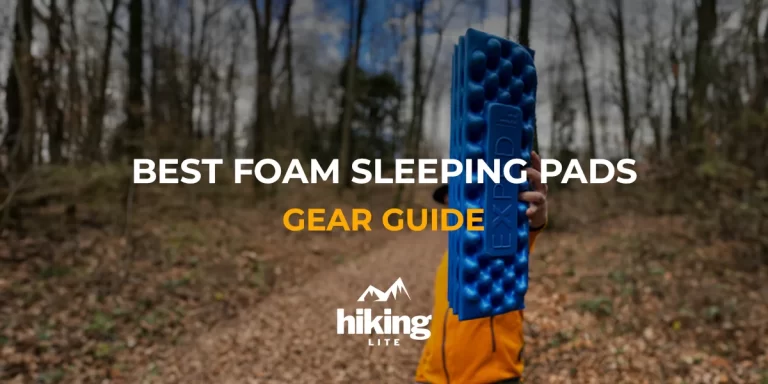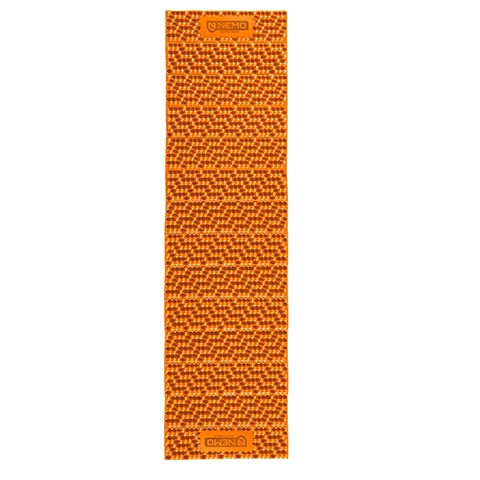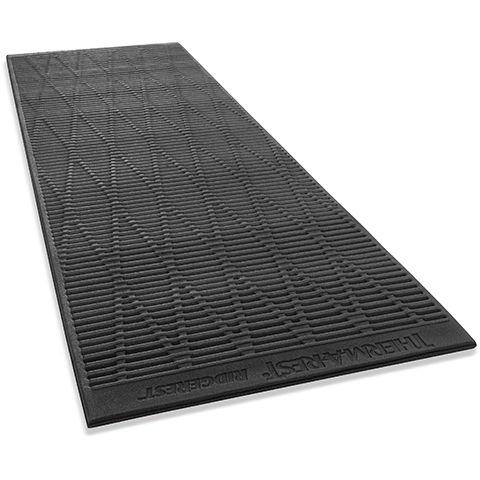

Finding the best foam sleeping pads can make all the difference in getting a good night’s sleep while camping or backpacking.
While inflatable pads offer more comfort and insulation, they often come with a higher price tag. That’s where foam sleeping pads come into play.
Lightweight and easy to carry, foam pads offer a budget-friendly option for camping and backpacking in warm weather, or they can be used in combination with an air mat to enhance insulation even further.
In this post, we’ll share our top 5 recommendations to help you find the best foam sleeping pad for your needs.

Key Specs
Weight: 12.27 ounces (348 grams)
R-Value: 1.5
Price: $
PROS
✅ Ultralight
✅ Durable
CONS
❌ Not the smallest pack size
The Exped FlexMat is a versatile and durable foam sleeping mat that’s a great option for ultralight backpackers.
Its foldable rectangular segments rapidly deploy for quick camp setup and its IXPE foam is remarkably lightweight yet sturdy enough for years of outdoor use.
While inflatable pads may be more compact, the FlexMat’s array of air-trapping cells creates a supportive, insulating sleep surface that conforms well to uneven ground.
One handy feature is the ability to stack the first few segments to create an elevated pillow area for head and neck comfort. The mat’s overall reliability and adaptability in various conditions make it a solid choice for minimalist adventures where weight savings matter.
For ultralight backpackers who prioritize practicality over luxe comfort, it’s a sleeping mat worth considering.

Key Specs
Weight: 14.46 ounces (410 grams)
R-Value: 2
Price: $$
PROS
✅ Durable
✅ Great insulation
CONS
❌ Some find it a bit narrow
The Thermarest Z Lite SOL sleeping pad lives up to its reputation as a favored ultralight pad among backpackers.
Its reflective ThermaCapture coating boosts warmth by reflecting radiant heat back to your body, and the pad’s heat-trapping dimples provide an R-value of 2.0 for reasonable warmth in summer conditions.
The Z Lite SOL earns points for its simple, virtually indestructible closed-cell foam design that packs down small and sets up quick. The proprietary foam is denser on the bottom for durability and softer on top for comfort.
While appreciated for its no-fail practicality, some users have mentioned a desire for a wider version to prevent arms from slipping off the edges at night.
But overall, the Thermarest Z Lite SOL continues to shine as an ultralight favorite, offering ample warmth for 3-season use coupled with unmatched durability and packability.

Key Specs
Weight: 14 ounces (397 grams)
R-Value: 1.7
Price: $$
PROS
✅ Enivornmentally friendly material
✅ Durable
CONS
❌ No transport strap
The TwisterCane sleeping pad from Big Agnes offers a more sustainable foam option for ultralight backpackers.
Made from over 60% sugarcane resin, the pad’s EVA foam contains material derived from crops grown and harvested responsibly.
As a closed-cell foam pad, the TwisterCane creates a firm, insulating barrier between you and the ground. One side features a smooth surface while the other has a tire-tread pattern for traction.
In testing, we’ve found the TwisterCane provides reliable protection for inflatable pads while adding warmth. The foam has held up well over time, though we noticed occasional minor nicks when catching on brush. One handy addition would be a strap for easier transport.
Overall, the TwisterCane pad offers a functional closed-cell foam option with the appeal of more eco-conscious materials.

Key Specs
Weight: 14.67 ounces (415 grams)
R-Value: 2
Price: $$
PROS
✅ Comfortable
✅ Great warranty
CONS
❌ A bit narrow
The Nemo Switchback ultralight backpacking sleeping mat has redefined the conventional closed-cell foam pad.
It offers increased thickness and plush comfort while keeping a compact size. The hexagonal nodes, crafted with dual-density Axiotomic foam, form zones that strike a perfect balance between comfort and support.
Furthermore, a thermal film layer reflects heat back to your body, resulting in a warmer and more comfortable experience compared to other pads.
We appreciate its comfort and improved packability. However, a significant concern arises from its width—20 inches might not be sufficient for everyone.
In general, the Nemo Switchback sleeping mat earns praise for its comfort and innovative design.

Key Specs
Weight: 14.1 ounces (400 grams)
R-Value: 2
Price: $
PROS
✅ Durable
✅ Relatively affordable
CONS
❌ Bit bulky
The Therm-a-Rest RidgeRest Classic ultralight backpacking sleeping mat rekindles the durability of the original design.
Constructed with sturdy foam, it assures extended utility, positioning itself as a prime selection for campers in pursuit of fundamental comfort.
We can commend its steadfast performance; the ideal width and density guarantee a tranquil night’s rest. However, the only drawback is its somewhat bulky pack size, which might not suit the most dedicated ultralight hikers.
All in all, the Therm-a-Rest RidgeRest Classic mat stands as a reliable alternative, esteemed for its endurance and comfort.
Choosing the right backpacking sleeping mat involves balancing convenience and comfort.
Closed-cell foam pads check both boxes, providing insulation and durability while doubling as sit pads around camp. When selecting a closed-cell foam pad, focus on two key factors:
Keeping size, weight, and warmth in mind will help you pick the ideal closed-cell foam sleeping pad.
If your 3-season camping extends into early spring and late autumn, look for an ultralight 3-season air inflatable sleeping pad instead.
When selecting a foam sleeping pad or camping mattress, prioritize portability, cushioning, and insulation. Look for a lightweight, compact pad that rolls or folds up neatly to fit inside or attach to your pack. Thinner pads are more portable but less cushioning – find the right balance of comfort and packability for your needs. Check the pad’s R-value for insulation capacity and aim for 1.5+ for adequate warmth. Durable closed-cell foam provides cushioning from the ground while resisting moisture. With foam pads, you can find an affordable, portable sleeping solution to cushion and insulate you in the outdoors.
Foam sleeping pads work best for warmer weather camping. Their low R-values and minimal cushioning make them less suitable for colder seasons compared to insulated air pads. For 3-season backpacking in spring, summer, and fall, foam pads provide adequate warmth when overnight lows stay above freezing. Pair them with a sleeping bag appropriate for the conditions. For winter camping, foam pads work better as a protective base layer under an air pad, not on their own. Unless specially designed for winter, foam pads alone won’t provide enough insulation and comfort on snow or frozen ground. Stick to 3-season camping to get the most out of your foam sleeping pad.
A foam pad’s durability depends on the type of foam and density rating. Closed-cell foam is more durable than open-cell. Look at the foam’s density measured in pounds per cubic foot (PCF) – higher density foam is more rigid and resilient. Density ratings around 1.5-2 PCF are a good minimum. Check user reviews on how well the pad holds up over time and maintains cushioning. Abrasion-resistant fabric helps for durability. Avoid thin pads under 1 inch, which compress easier. See how compactly the pad folds or rolls – bulky packs take up more space but resist creasing. With quality materials and construction, a foam pad should last for many seasons of use.